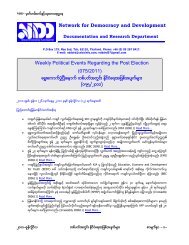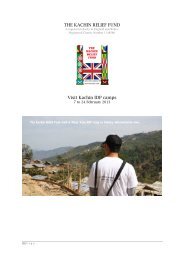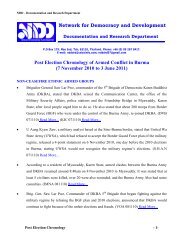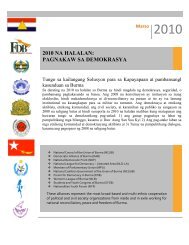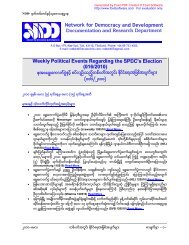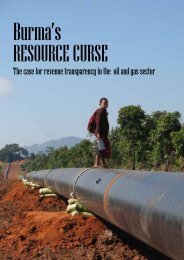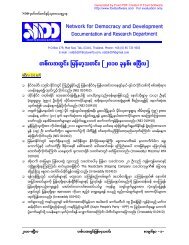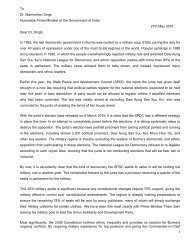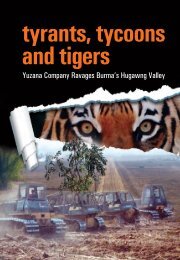Cyclone Giri - Two Years On - Burma Action Ireland
Cyclone Giri - Two Years On - Burma Action Ireland
Cyclone Giri - Two Years On - Burma Action Ireland
Create successful ePaper yourself
Turn your PDF publications into a flip-book with our unique Google optimized e-Paper software.
Arakan Human Rights and Development Organisation<br />
Social forestry is:<br />
“a forestry which aims at ensuring economic, ecological, and social benefits to the people, particularly<br />
to the rural masses and those living below poverty line, especially by involving the beneficiaries right<br />
from the planning stage to the harvesting stage. The target of the social forestry is the ‘rural poor’ and<br />
not the ‘tree’ alone.” 128<br />
For sustainable forest resources, it is vital to ensure the active participation of the people. In the Delta<br />
a beginning has been made by the Forest Department of the Ministry of Forestry and the International<br />
Tropical Timber Organisation. 129 This can be seen as a positive first step to improving the livelihoods of<br />
citizens in the Delta area.<br />
Apart from mangrove forests, coral reefs also function as natural barriers to storm surges. 130 However<br />
this natural defence is also being damaged due to the construction of the Shwe Gas pipeline, an undersea<br />
pipeline 131 three miles north of Kyaukphru. <strong>On</strong>e third of the coral reefs have been severely damaged by<br />
dynamite dredging. 132<br />
4.4 Nargis: a watershed in “lessons learned” 133<br />
“The disaster in the Ayeyarwady Delta was not just a cyclone, which is a natural event. The disaster<br />
was the preventable deaths and damage due to a lack of preparedness and disaster risk reduction.”<br />
Robert Turner et al., Inter-Agency Real Time Evaluation of the Response to <strong>Cyclone</strong> Nargis 134<br />
<strong>Cyclone</strong> Nargis, which struck the Irrawaddy Delta on 2 May 2008 135 was one of the worst natural<br />
disasters to hit <strong>Burma</strong> in living memory. Nargis should have provided the experience and the best<br />
lessons for the junta in respect of how to prepare for and respond to future natural disasters: but little<br />
was done to prepare for future cyclones.<br />
The difference in death toll between Nargis and <strong>Giri</strong>, both with similar wind speeds, may be explained by<br />
a number of factors, including:<br />
1. Despite several days advance knowledge, there was a total lack of any official warning from the<br />
government when Nargis struck. However there were some warnings issued prior to <strong>Cyclone</strong><br />
<strong>Giri</strong>, both on the internet and over the radio. Because people had experienced Nargis recently<br />
they were somewhat aware of what was coming. There is some debate, regarding whether the<br />
warnings fully communicated the danger and the potential impact of the impending storm.<br />
2. The Irrawaddy Delta has shallow water compared to the much deeper water of the Arakan coast<br />
and this meant that the storm surge created by <strong>Cyclone</strong> Nargis was able to reach deeper inland.<br />
3. The Irrawaddy Delta is lower lying and closer to sea level than Arakan State, again making it<br />
more vulnerable to storm surges and flooding.<br />
4. The population density is much lower in Arakan State, which in 2008 was 88/km², compared<br />
with 224/km² for Irrawaddy State. 136<br />
In the aftermath of destruction brought by cyclone Nargis, there were some realisations and some lessons<br />
learned:<br />
There was some advance warning, limited evacuation and prepositioning of relief supplies. 137<br />
This, without question, played a huge part in reducing the death toll caused by <strong>Giri</strong>, especially in<br />
comparison to the impact of <strong>Cyclone</strong> Nargis; 138<br />
After the 1968 Sitetway cyclone there was no civil society response, since no civil society existed<br />
then, and the entire relief effort was spearheaded by the U Nu government: during the Nargis<br />
response new, truly independent and experienced civil society organisations emerged, which<br />
sought to address other humanitarian/development challenges in the country; 139 and<br />
After Nargis the people forced the government to include information on emergency preparedness<br />
in the school curriculum. 140<br />
However some post-Nargis lessons were not acted upon in the post-<strong>Giri</strong> relief and recovery:<br />
22





